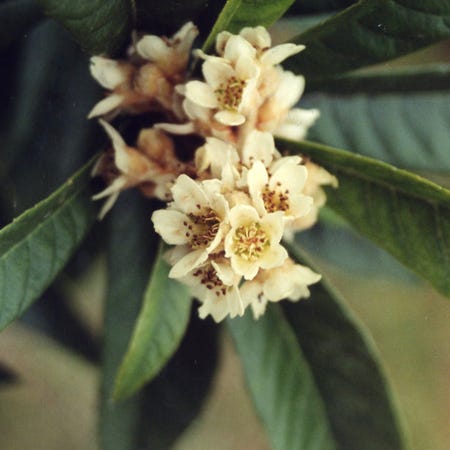





































Eriobotrya Japonica
About Eriobotrya Japonica
A tropical evergreen shrub or tree with alternate, simple leaves that are leathery, veiny, and toothed. Fire blight can be troublesome on this tree. The bacterium that causes fire blight, Erwinia amylovora, is spread by rain and insects.
Taxonomy

Eriobotrya japonica
Rhaphiolepis
Rosaceae
Rosales
Also known as
Loquat, Loquat, Japanese medlar, Japanese plum, Chinese plum, Pipa and Nespola

How to care for Eriobotrya Japonica
How often to water your Eriobotrya Japonica

every 9
Eriobotrya Japonica needs 0.5 cups of water every 9 when it doesn’t get direct sunlight and is potted in a 5" pot.
Use our water calculator to personalize watering recommendations to your environment or download Greg for more advanced recommendations for all of your plants.

Water 0.5 cups every
9
Finding light for Loquat in your home

a window
Eriobotrya Japonica love being close to bright, sunny windows 😎.
Place it less than 1ft from a south-facing window to maximize the potential for growth.
Eriobotrya Japonica does not tolerate low-light 🚫.
Select your region to see how the current weather in your area affects the placement of Eriobotrya Japonica in your home 🏡.
How to fertilize Eriobotrya Japonica

Most potting soils come with ample nutrients which plants use to produce new growth.
By the time your plant has depleted the nutrients in its soil it’s likely grown enough to need a larger pot anyway.
To replenish this plant's nutrients, repot your Eriobotrya Japonica after it doubles in size or once a year—whichever comes first.
Care Summary for Eriobotrya Japonica

Eriobotrya Japonica
 Greg recommends:
Greg recommends:
 Water
Water
0.5 cups every 9 days
 Placement
Placement
< 1ft from a window
 Nutrients
Nutrients
Repot after 2x growth
Based on the 4” pot your plant is in, and that it doesn’t get direct sunlight.

 Trending in your area
Trending in your area
 Similar to Eriobotrya Japonica
Similar to Eriobotrya Japonica
✨ Discover rare plants

Chandelier Plant

Electric Blue Gecko

Raphionacme flanaganii

Echeveria Esther

Scotch Moss

Hoya sipitangensis

Marquise de Sevigne

Hoya 'Memoria'

Philodendron 'Silver …

Variegated Arrowhead …

Cereus peruvianus 'Pa…

Pink Ruby Sedevaria

Stanhopea tigrina

Phalaenopsis schiller…

Hoya kalimantan




























